As Russia Unleashes One of War’s Largest Aerial Assaults Following Operation Spiderweb, Trump Justifies Putin’s Brutality While Ukraine Strikes Back at Strategic Bomber Bases
Summary of the Day – June 6, 2025
Russia launched one of the war’s largest aerial assaults—452 drones and 45 missiles—killing five civilians and wounding 73 across Ukraine, fulfilling Putin’s retaliation threat for Operation Spiderweb. As Ukrainian cities burned, President Trump justified the carnage, claiming Ukraine “gave Putin a reason to bomb the hell out of them.” Ukrainian forces countered with preemptive strikes on Russian airfields, destroying helicopters and igniting fuel depots at Engels and Dyagilevo bases. Intelligence revelations exposed Moscow’s territorial maximalism: plans to seize all Ukrainian territory east of the Dnipro River by 2026, cutting off Black Sea access. The day crystallized the chasm between peace negotiations and Putin’s war objectives.
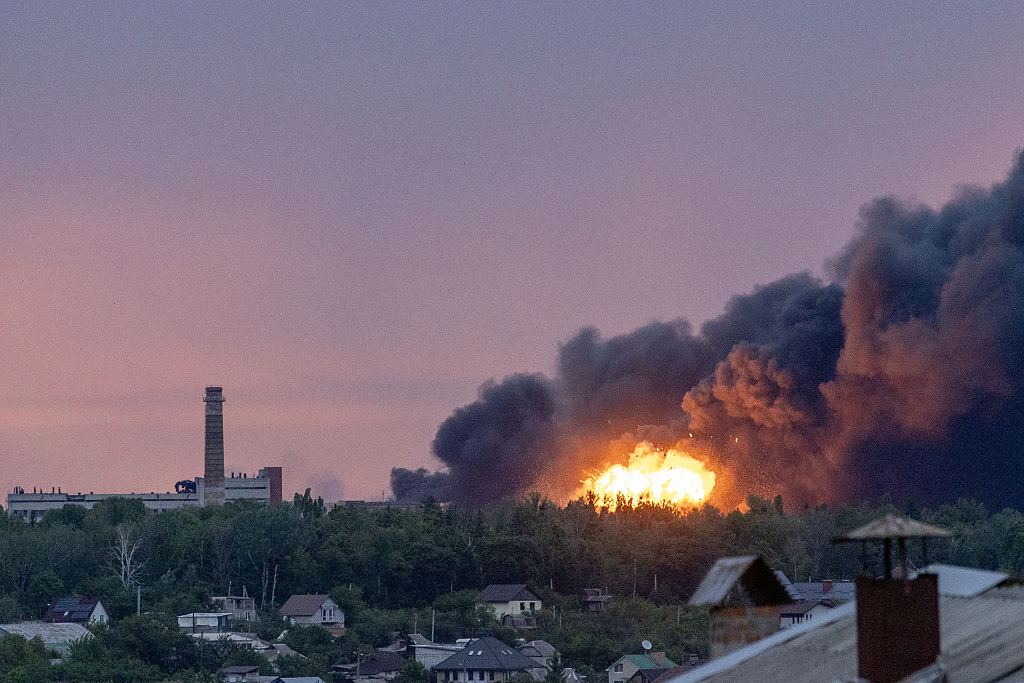
Fire is seen among the smoke clouds billowing from a Russian attack on Kharkiv, Ukraine. (Daniel Cardenas/Anadolu via Getty Images)
The Reckoning: Putin’s Promise Becomes Ukrainian Nightmare
The aerial holocaust that descended upon Ukraine in the pre-dawn hours of June 6 represented more than mere military retaliation—it was Putin’s definitive answer to those still harboring hopes for meaningful ceasefire negotiations. The scale was breathtaking: 452 drones, including the signature Iranian-designed Shahed suicide drones, accompanied by 45 missiles of various types, creating what Ukrainian officials described as the second-largest coordinated attack of the entire war.
The assault struck with surgical precision at the heart of Ukrainian society. In Kyiv alone, at least four civilians perished, including first responders who died trying to save others. The capital’s mayor, Vitali Klitschko, reported 20 injured, with 16 requiring hospitalization as fires raged across multiple districts. But the carnage extended far beyond the capital—from Volyn Oblast in the west, where 15 were wounded when drones tore through apartment buildings, to Ternopil Oblast, where 10 civilians including five emergency workers fell victim to the mechanized terror.
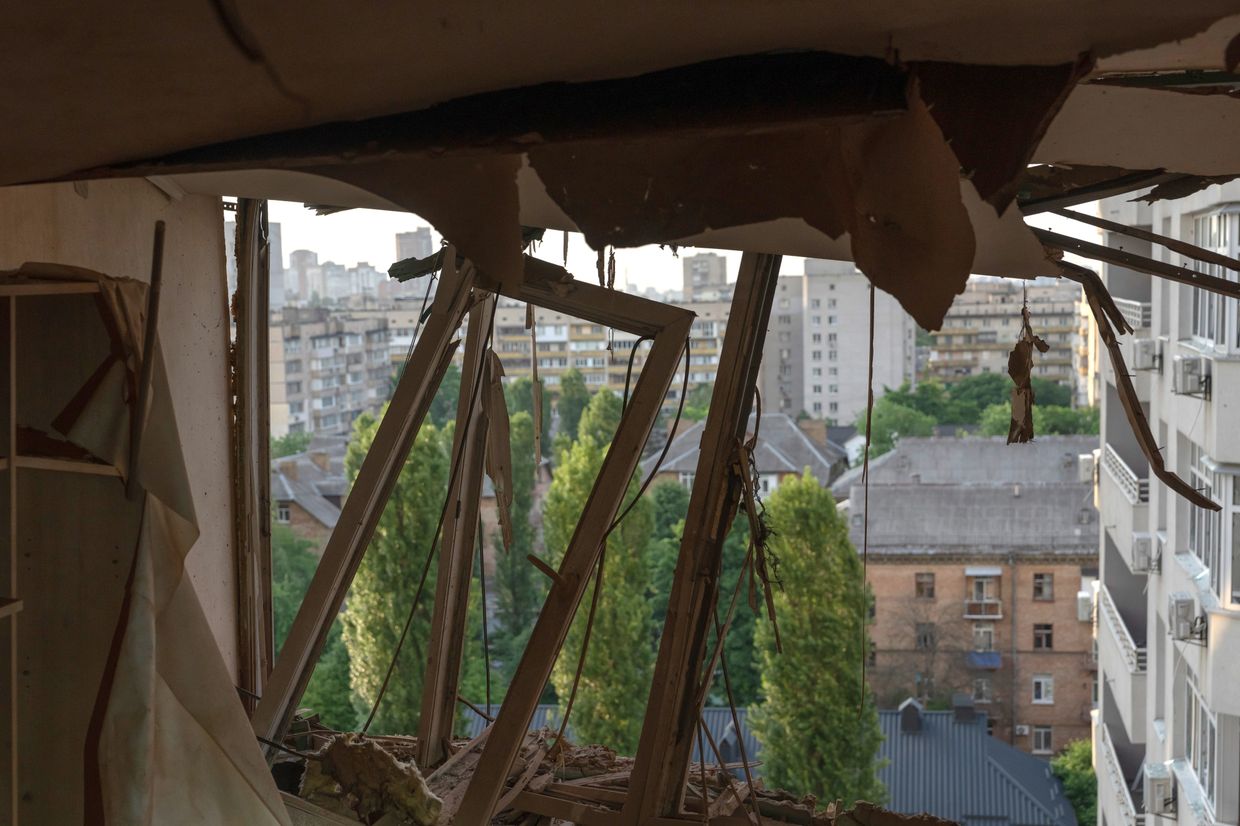
A burned out apartment following a Russian overnight attack in Kyiv, Ukraine. (Andrew Kravchenko / Bloomberg via Getty Images
Ukrainian President Volodymyr Zelensky’s response captured the grim irony of the moment: “Russia doesn’t change its stripes—another massive strike on cities and ordinary life. They targeted almost all of Ukraine.” The timing was no accident. This was Putin fulfilling his explicit promise to Trump during their phone conversation just one day earlier, when the Russian leader vowed to retaliate for Ukraine’s Operation Spiderweb strikes against his strategic bomber fleet.
Trump’s Troubling Justification: When Victims Become Villains
Perhaps more shocking than the scale of Russian brutality was the response from the American president who has positioned himself as a peacemaker. Flying aboard Air Force One as Ukrainian emergency workers pulled bodies from the rubble, Trump offered a stunning justification for Putin’s assault: “They gave Putin a reason to go in and bomb the hell out of them last night. That’s the thing I don’t like about it.”
The comment revealed the dangerous calculus underlying Trump’s approach to the conflict. By framing Ukraine’s defensive strikes against legitimate military targets as provocative, while treating Russia’s deliberate targeting of civilian infrastructure as an understandable response, Trump had effectively inverted the moral framework of the war. His comparison of the conflict to “kids fighting” on a playground—”sometimes you’re better off letting them fight for a while”—reduced a struggle for national survival to a schoolyard squabble.
This rhetorical shift carries profound implications for American policy. The White House is reportedly debating whether to scale back support for Ukraine following Operation Spiderweb, with administration officials expressing concern that Kyiv might be “dragging the United States toward a wider war.” The irony is stark: the nation that pioneered precision bombing campaigns and preemptive strikes now questions Ukraine’s right to target the very airfields launching daily attacks against its cities.
Operation Retribution: Ukraine Strikes Back at Russian War Machine
Even as Russian missiles fell on Ukrainian soil, Ukrainian forces demonstrated their evolving capacity to project power deep into enemy territory. In what military officials described as “preemptive strikes,” Ukrainian drones targeted the heart of Russia’s strategic aviation infrastructure hours before Moscow’s massive retaliation.
The Engels-2 air base in Saratov Oblast, nearly 600 kilometers from Ukrainian lines, became a spectacular inferno as Ukrainian strikes ignited fuel tanks and triggered massive explosions. This facility, home to Russia’s Tu-95, Tu-22M3, and Tu-160 bombers—the very aircraft that launch cruise missiles at Ukrainian cities—suffered significant damage as fires raged across the complex. The symbolism was unmistakable: Ukraine was striking at the sources of its torment, even as those sources prepared their next assault.
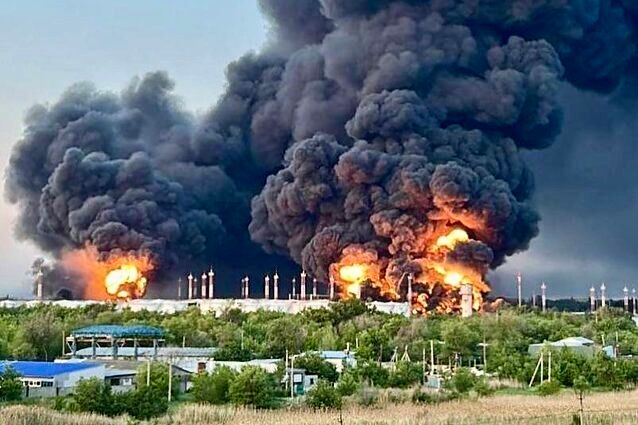
Fuel tanks in the city of Engels in Russia’s Saratov Oblast were engulfed in flames after an overnight Ukrainian drone attack (Astra / Telegram)
Simultaneously, the Dyagilevo airfield in Ryazan Oblast, which houses the air refueling tankers that enable Russia’s long-range bombing campaigns, came under attack. Ukrainian forces also struck Russian logistics centers in Kursk Oblast, targeting the 30th Motorized Rifle Regiment of Russia’s 72nd Division. At Bryansk International Airport, Ukrainian drones destroyed a Mi-8 helicopter and damaged a Mi-35 gunship, showcasing the expanding scope of Ukraine’s retaliatory capabilities.
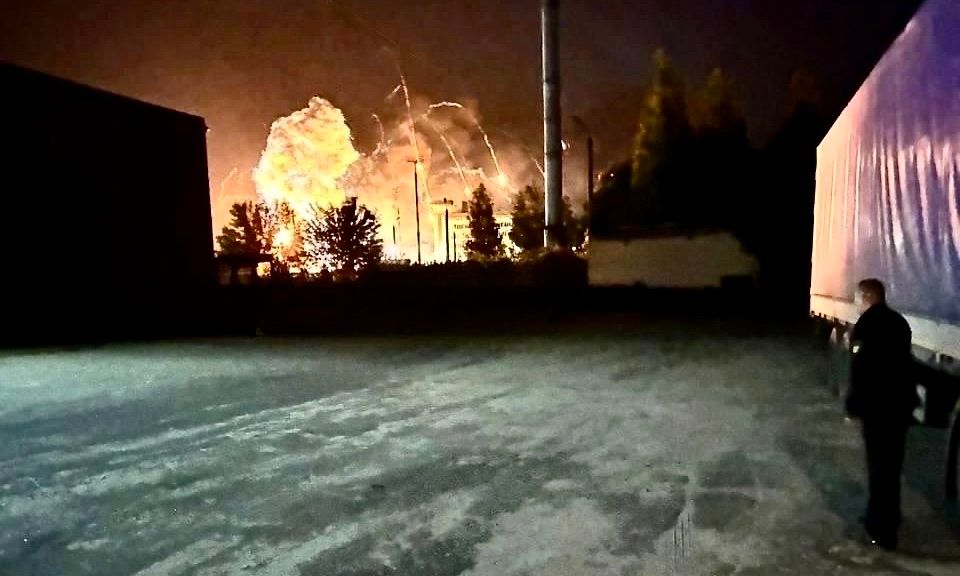
Ukrainian drones struck the Bryansk International Airport overnight, destroying a Mi-8 helicopter. (Astra / Telegram)
The Ukrainian General Staff’s message was unambiguous: “Strikes on military infrastructure will continue until the Russian Federation’s armed aggression against Ukraine is completely stopped.”
The Economic Mirage: Russia’s Central Bank Bows to Kremlin Pressure
Amid the military escalation, Russia’s Central Bank made a telling economic decision that revealed the mounting pressures within Putin’s war economy. For the first time since September 2022, the bank lowered its key interest rate from 21% to 20%, marking a surrender to political pressure despite ongoing inflationary concerns.
The rate cut, coming after months of reported tensions between Central Bank Chairperson Elvira Nabiullina and Putin himself, exposed the contradictions at the heart of Russia’s war financing. While officially attributed to cooling inflation—which allegedly fell from 10.7% to 6.2%—the decision reflected growing complaints from Russian industry about the crushing cost of credit.
VTB Bank head Andrei Kostin’s confident prediction that rates would fall, coupled with Bloomberg reports of Kremlin pressure on Nabiullina, suggested that political considerations had trumped economic prudence. Russian steel producer Severstal’s admission of a 33 billion ruble loss in the first quarter underscored the broader crisis facing Russian industry under the weight of war economics and international sanctions.
The timing of this decision, coinciding with the largest military assault in months, revealed a regime increasingly forced to choose between economic stability and military ambition—and consistently choosing war.
Moscow’s Grand Design: The Blueprint for Ukrainian Dismemberment
As bombs fell on Ukrainian cities, revelations emerged about the true scope of Russian ambitions that rendered any talk of limited objectives obsolete. Ukrainian Presidential Office Deputy Head Pavlo Palisa disclosed intelligence indicating that Russia plans to seize all Ukrainian territory east of the Dnipro River and advance toward Odesa and Mykolaiv—a strategy designed to completely sever Ukraine’s access to the Black Sea by 2026.
The plan unfolds in phases of breathtaking audacity. By September 2025, Russia aims to capture the entirety of Donetsk and Luhansk oblasts while establishing a buffer zone along Ukraine’s northern border. The second phase envisions even more ambitious territorial seizures: the complete occupation of Ukraine’s left bank, including major cities like Zaporizhzhia, Dnipro, Kharkiv, Sumy, Chernihiv, and Poltava—urban centers with a combined pre-war population exceeding 5.6 million people.
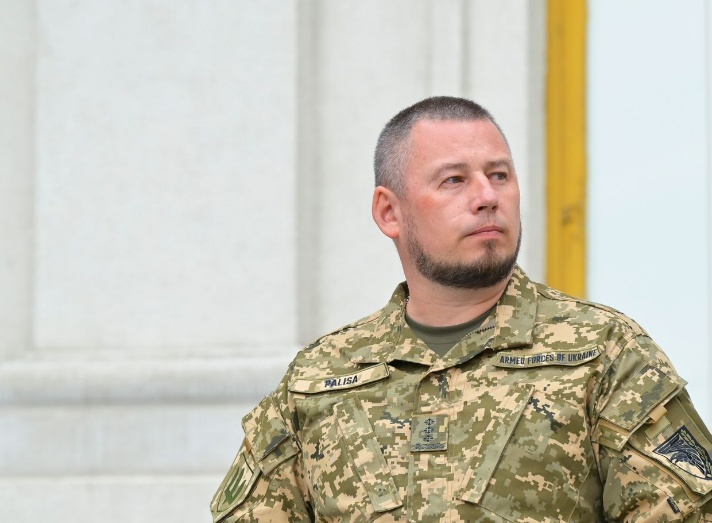
President Volodymyr Zelensky’s Deputy Chief of Staff Pavlo Palisa near Ministry of Foreign Affairs of Ukraine in Kyiv. (Artem Gvozdkov / Global Images Ukraine via Getty Images)
This territorial maximalism extends far beyond Russia’s formal annexation claims, encompassing roughly 336,300 square kilometers—nearly double the territory Russia held during the initial 2022 invasion. The plan would require advancing over 300 kilometers from the international border to reach Kyiv, while simultaneously conducting complex amphibious operations across the Dnipro River to seize western Kherson Oblast.
“Unfortunately, they are not speaking about peace. They are preparing for war,” Palisa warned during a briefing at the Ukrainian Embassy in Washington, his words carrying new urgency after the morning’s devastation.
The Peaky Blinders: Ukraine’s Elite Drone Hunters in Action
Against this backdrop of strategic planning and diplomatic maneuvering, the daily reality of the war continued to unfold in the trenches and treelines of Donetsk Oblast. The elite Ukrainian drone unit known as the Peaky Blinders—named after the television series and identifiable by their custom flat caps—demonstrated the evolving nature of modern warfare as they hunted Russian assault troops with modified civilian drones.
Operating from camping chairs in a treeline near Pokrovsk, this six-man team exemplified Ukraine’s adaptation to Russian tactics. Armed with DJI Mavic drones carrying specially designed “Foot Crusher” munitions packed with hundreds of metal balls, they had eliminated 106 Russian soldiers in just five days—a kill rate exceeding most entire specialized drone battalions.
Commander Oleksandr “Zalizniak” embodied the grim efficiency of this new warfare. Watching his drone footage of two Russian soldiers burning alive after his munition ignited their fuel canister, he observed with dark humor: “Look at the two of them, they burned up at work.” For him, each eliminated Russian soldier meant Ukrainian infantry who might return home alive—a calculus that had become the harsh mathematics of survival.
The unit’s motto, “To find and destroy,” reflected a philosophy born of necessity. Unlike traditional reconnaissance-strike combinations, the Peaky Blinders conducted both functions simultaneously, providing immediate response to Russian infantry assaults that had become the primary threat to Ukraine’s overstretched defensive lines.
Diplomatic Theater: Peace Talks Amid Preparation for War
The contrast between diplomatic rhetoric and military reality reached absurd proportions as peace talks continued in Istanbul even as explosions rocked Ukrainian cities. Russia’s so-called “peace memorandum,” presented during June 2 negotiations, demanded nothing less than Ukraine’s complete capitulation: recognition of illegal annexations, withdrawal from four oblasts, demobilization, and a formal NATO membership ban.
Ukraine’s counter-proposal—calling for prisoner exchanges, return of abducted children, and a 30-day ceasefire—highlighted the unbridgeable gap between the parties. Moscow’s immediate rejection of any meaningful pause in hostilities, followed by the massive June 6 assault, demonstrated that Russia views negotiations as a tool for buying time to advance its military objectives rather than a genuine path to peace.
The tragic irony was captured by a Kyiv resident named Alicia, surveying damage from the morning’s strikes: “Are we supposed to believe in a ceasefire after today? I think it’s a farce, and it was clear from the very beginning that there would be no truce.”
The Kremlin’s Existential Rhetoric: When Aggression Becomes Self-Defense
As international pressure mounted for meaningful peace negotiations, Kremlin spokesman Dmitry Peskov offered perhaps the most revealing insight into Russian thinking. Describing the war as “existential” for Russia—”an issue on our national interest, safety, on our future and the future of our children”—Peskov presented the aggressive war as defensive necessity.
This rhetorical inversion, transforming Russia’s unprovoked invasion into an existential struggle for survival, provided the psychological framework for unlimited escalation. If Ukraine’s very existence threatens Russia’s future, then any level of violence becomes justifiable, any civilian target becomes legitimate, and any international law becomes irrelevant.
The language reflected a regime that had painted itself into a corner where victory wasn’t just desired but necessary for survival—a mindset that made genuine compromise virtually impossible.
The Intelligence War: Recruitment Deceptions and Military Realities
Behind the headlines of dramatic drone strikes and diplomatic theater, the war’s underlying dynamics continued to shift in Ukraine’s favor. Russian recruitment efforts, despite official claims of 450,000 new contracts in 2024, showed signs of serious strain. Independent analysis suggested actual recruitment numbers were significantly lower, possibly inflated by factors of 1.5 or more.
Russian federal subjects were employing increasingly desperate tactics: dynamic pricing schemes, online job platform deceptions, recruitment of foreigners, compensation for bringing friends to enlistment centers, and even formation of all-female detachments. The Russian military’s expansion into the Africa Corps branding and recruitment of Ukrainian teenagers in occupied territories for drone production revealed the breadth of Moscow’s manpower crisis.
The disparity between official claims and independent estimates suggested a military command increasingly willing to deceive even its own leadership about the war’s sustainability—a dangerous dynamic that could lead to strategic miscalculations.
International Implications: America’s Wavering Resolve
The June 6 assault occurred against a backdrop of shifting American policy that raised profound questions about Western resolve. Trump’s repeated delays in imposing new sanctions on Russia, coupled with reports of White House pressure to weaken Congressional sanctions legislation, suggested an administration increasingly reluctant to confront Moscow decisively.
Republican Senator Lindsey Graham’s revelation that Trump had asked the Senate to postpone voting on a bipartisan sanctions bill highlighted the disconnect between Congressional and executive branch approaches. The legislation, which would impose 500% tariffs on countries purchasing Russian oil, represented exactly the kind of economic pressure that might actually influence Putin’s calculations.
Instead, Trump’s repeated threats of sanctions “on both sides” if fighting continued reflected a fundamental misunderstanding of the conflict’s nature. By treating Ukraine’s defensive struggle as equivalent to Russia’s aggressive war, American policy risked validating Putin’s narrative while undermining the moral clarity that had sustained international support for Kyiv.
The Technology Race: Drones, Lasers, and Electronic Warfare
The June 6 attacks showcased the evolving technological dimension of the conflict, as both sides raced to develop countermeasures to emerging threats. Russian forces deployed Chinese-made Silent Hunter laser air defense systems capable of intercepting drones at distances exceeding 1.3 kilometers, while also testing jet-powered Dan-M drones that could be launched from Mi-8 helicopters.
Ukraine’s expanding drone capabilities, demonstrated through Operation Spiderweb and the June 6 retaliatory strikes, reflected a technological adaptation that was shifting the war’s strategic balance. The ability to strike targets hundreds of kilometers inside Russia fundamentally altered the conflict’s geography, forcing Moscow to defend assets it had previously considered safe.
The development of fiber-optic drones, unjammable by electronic warfare systems, represented a particularly significant evolution. These weapons promised to overcome the electronic warfare advantages that had previously protected high-value targets, potentially revolutionizing deep-strike capabilities for both sides.
The Human Cost: When Statistics Become Stories
Amid the strategic analyses and diplomatic maneuvering, the human dimension of the conflict continued to assert itself with heartbreaking clarity. The murder of a Ukrainian woman and her 6-year-old daughter in Belgium—the child’s father fighting on the front lines—illustrated how the war’s trauma extended far beyond Ukraine’s borders.
In Ukraine itself, the daily casualty reports had become a grim routine: five killed and 73 wounded in the June 6 assault alone, bringing the total suffering to numbers that had long since ceased to shock. Each statistic represented a family destroyed, a future stolen, a life reduced to a line in a military report.
The contrast between the clinical language of military briefings and the reality of civilian suffering created a dangerous disconnect. As international attention focused on diplomatic initiatives and strategic implications, the fundamental human stakes of the conflict risked being lost in a fog of geopolitical abstraction.
Economic Warfare: The Battle for Ukraine’s Future
Ukraine’s announcement that it would need to revise its 2025 budget to accommodate increased defense spending highlighted the war’s relentless economic pressure. With defense expenditures already consuming 75% of the state budget in the first quarter, the additional requirements threatened to push the country toward fiscal crisis.
Finance Minister Serhiy Marchenko’s acknowledgment that current military funding was insufficient “for various reasons” reflected the complex challenges facing a nation fighting for survival while trying to maintain economic stability. The proposed plan for Western financing of Ukrainian military capabilities, presented to G7 representatives, represented a creative attempt to address these pressures while serving broader European security interests.
The economic dimension of the conflict had become inseparable from its military aspects. Russia’s ability to sustain its war machine depended heavily on energy revenues, while Ukraine’s survival required not just military aid but comprehensive economic support. The battle for Ukraine’s future would be won or lost as much in budget spreadsheets as on battlefield maps.
The Sanctions Standoff: Congressional Will Meets Presidential Hesitation
Behind the scenes in Washington, a telling struggle emerged over the very tools that might pressure Putin toward genuine negotiations. The White House was quietly urging Republican Senator Lindsey Graham to soften his bipartisan sanctions bill against Russia, seeking to insert waivers that would essentially defang the legislation by changing mandatory language from “shall” to “may.”
The proposed bill, which would impose a crushing 500% tariff on countries purchasing Russian oil, represented exactly the kind of economic pressure that had historically influenced Moscow’s strategic calculations. Yet Trump’s request to postpone Senate voting revealed an administration more concerned with preserving flexibility for its own diplomatic initiatives than applying decisive pressure on Russian decision-making.
Congressional staffers reported that Trump officials wanted to insert presidential waivers allowing the administration to choose which entities would face sanctions—effectively gutting the bill’s automatic enforcement mechanisms. The struggle highlighted a fundamental tension between legislative determination to confront Russian aggression and executive branch reluctance to foreclose diplomatic options that might not exist.
Meanwhile, the European Union moved closer to placing Russia on its “gray list” of countries with inadequate money laundering controls, a designation that would further isolate Moscow from global financial markets while increasing compliance costs for any remaining cross-border operations. The delayed decision, expected early the following week, reflected the careful calibration required for economic warfare in an interconnected global system.
The G7 Gambit: Zelensky’s Strategic Summit Planning
As bombs fell on Ukrainian cities, President Zelensky’s chief of staff Andriy Yermak confirmed plans for a crucial meeting with Trump during the upcoming G7 summit in Canada, scheduled for June 15-17. The meeting, arranged in part through a Ukrainian delegation’s recent trip to Washington, would represent a critical test of the relationship between the two leaders amid growing tensions over Operation Spiderweb and its aftermath.
Zelensky’s positioning for the summit reflected Ukraine’s recognition that American support remained essential despite Trump’s troubling rhetoric. The president’s stated desire for defense agreements and a free trade deal with the United States—”no gifts,” as he emphasized—represented an attempt to reframe the relationship from aid recipient to strategic partner and customer.
The summit’s timing, coming just days after the June 6 assault and Trump’s justification of Russian retaliation, would provide a crucial gauge of whether the American president remained committed to Ukrainian victory or was preparing to pressure Kyiv toward accommodation with Moscow’s territorial demands.
Turkish President Recep Tayyip Erdogan’s proposal for a four-way summit including himself, Trump, Putin, and Zelensky added another layer of complexity to the diplomatic maneuvering. Zelensky’s expressed willingness to participate reflected his assessment that “there will be no ceasefire without our meeting”—a recognition that the conflict’s resolution ultimately required direct engagement between the principal antagonists.
Blood on Foreign Soil: The War’s Expanding Human Toll
The conflict’s human dimensions extended far beyond Ukraine’s borders, as demonstrated by the shocking murder of a 46-year-old Ukrainian woman and her 6-year-old daughter in Leuven, Belgium. The victims, found stabbed and burned in what authorities suspected was a deliberate fire, represented the war’s capacity to destroy innocent lives even in the supposed safety of European exile.
The murdered woman’s 16-year-old son was at school when the attack occurred, while her husband served on the front lines in Ukraine—a family torn apart by war and then destroyed by violence in what should have been a place of refuge. The incident highlighted the vulnerability of Ukrainian refugees across Europe and the psychological trauma that followed them wherever they sought shelter.
This tragedy joined a growing list of attacks on Ukrainian citizens across European cities, including hate-motivated assaults that revealed how the war’s propaganda had poisoned minds far from the battlefield. Each incident served as a reminder that the conflict’s true costs couldn’t be measured solely in military casualties or territorial control.
Moscow’s Asylum Theater: The Musk-Putin Diplomatic Dance
In a surreal diplomatic sidebar, Russian officials offered political asylum to tech billionaire Elon Musk following his public feud with Trump over federal spending policies. Deputy State Duma Chair Dmitry Novikov’s statement that “Russia could certainly provide” asylum to the Tesla CEO represented both genuine outreach and calculated theater designed to exploit American political divisions.
The offer came as Musk’s 130-day stint heading a federal efficiency commission ended amid deepening tensions with Trump over the administration’s tax proposals. Musk’s criticism of the “Big Beautiful Bill” and Trump’s personal attacks in response provided Russia with an opportunity to position itself as a refuge for disaffected American tech leaders.
Dmitry Medvedev’s joke about Moscow brokering peace between “D and E” in exchange for Starlink shares captured the cynical calculation behind Russian diplomatic gestures. By offering sanctuary to one of America’s most prominent entrepreneurs, Moscow sought to demonstrate that even Trump’s closest allies might find Russian hospitality preferable to American political volatility.
The episode highlighted how Russian information warfare had evolved to exploit not just international tensions but domestic American political conflicts, seeking to undermine Western unity through calculated amplification of internal divisions.
The Gray Zone Battle: Covert Operations and Intelligence Warfare
The June 6 events unfolded against a backdrop of intensifying covert operations that rarely made headlines but shaped the conflict’s underlying dynamics. Russia’s National Guard claimed to have killed a man attempting a drone attack on a military facility in Ryazan Oblast, allegedly thwarting a “terrorist attack” on a state security installation.
The incident, occurring in the same region targeted by Ukrainian strikes, highlighted the shadow war of sabotage and counter-sabotage that had become integral to the broader conflict. Whether the alleged attack represented genuine Ukrainian infiltration, Russian false flag operations, or domestic resistance remained unclear—but the claim itself served Moscow’s narrative of defending against terrorist threats.
Similarly, reports of Russian recruitment of Ukrainian teenagers in occupied territories for drone production at the Alabuga Special Economic Zone revealed the conflict’s exploitation of the most vulnerable populations. The recruitment drives, advertised on billboards in occupied Luhansk Oblast, represented both strategic necessity and moral corruption as Moscow sought to force Ukrainian children to build weapons against their own country.
These gray zone operations, conducted beneath the threshold of conventional warfare, often proved as consequential as headline-grabbing missile strikes or territorial advances. They represented the conflict’s true nature: not a limited territorial dispute but a comprehensive struggle for political, economic, and social control.
The Frontline Reality: Russian Advances and Ukrainian Resistance
While diplomatic attention focused on peace talks and retaliatory strikes, the grinding reality of territorial warfare continued across multiple sectors of the thousand-kilometer front line. Russian forces achieved tactical advances in several directions, demonstrating that Moscow’s territorial ambitions weren’t merely theoretical projections but active military objectives.
In Belgorod Oblast, geolocated footage confirmed Russian advances south of Demidovka, northwest of Belgorod City, as Moscow continued efforts to establish defensive positions along the international border. The advances, though limited in scope, reflected Russia’s determination to create buffer zones that could protect its own territory from Ukrainian cross-border operations.
More significantly, Russian forces recently seized Fedorivka in the Velyka Novosilka direction, with the Defense Ministry confirming the capture alongside claims of additional advances west of the settlement. The methodical progress in this sector, combined with ongoing operations near Lyman where Russian forces advanced in the Serebryanske forest area, demonstrated the sustained pressure Ukrainian defenders faced across multiple axes.
In Sumy Oblast, Russian forces recently advanced south of Andriivka and likely seized the settlement, while additional advances southeast of Yablunivka highlighted Moscow’s efforts to expand its northern buffer zone. These tactical gains, measured in hundreds of meters rather than kilometers, nonetheless represented the cumulative pressure that could eventually achieve strategic objectives through patient accumulation of minor victories.
Voices from the Abyss: A Daughter’s Plea from Kyiv
Amid the strategic calculations and diplomatic maneuvering, a single social media post captured the human reality more powerfully than any official statement. Meaghan Mobbs, daughter of U.S. Special Envoy Keith Kellogg, wrote directly to her father during the massive Russian assault: “Loud night in Kyiv, Dad! It might be the explosions and gunfire in the dead of night, but I get the strange feeling the Russians don’t want peace.”
The message, posted as 452 drones and 45 missiles rained down on Ukrainian cities, represented more than family communication—it was a firsthand witness account from someone with direct access to American decision-makers. Mobbs, a former paratrooper who had delivered over 10,000 pallets of medical supplies to Ukrainian hospitals, embodied the personal connections that made this conflict more than geopolitical abstraction for many Americans.
Her observation about Russian intentions, delivered with bitter irony as explosions lit up the Kyiv sky, highlighted the disconnect between those experiencing the war’s reality and those crafting policy from distant capitals. The fact that a senior American diplomat’s daughter was personally witnessing Putin’s “response” to peace overtures provided a stark counterpoint to Trump’s justification of Russian actions.
The Recruitment Crisis: Numbers, Lies, and Desperation
Behind the headlines of territorial advances and diplomatic initiatives, Russia faced a deepening crisis in military recruitment that threatened the sustainability of its entire war effort. Independent analysis revealed significant discrepancies between official claims and actual recruitment numbers, suggesting a military command increasingly willing to deceive even its own leadership about the war’s human costs.
Russian opposition outlet iStories estimated that Moscow recruited between 374,200 and 407,200 people in 2024, significantly below Defense Minister Andrei Belousov’s claim of 427,000 contracts. More troubling for Russian planners, recruitment rates appeared to be declining even as financial incentives increased, with daily contract signings falling from 2,236 per day in late 2023 to 1,706 per day in the same period of 2024.
The response revealed desperation masked as innovation. Regional authorities were employing dynamic pricing schemes, increasing enlistment bonuses by factors of three since early 2025. The military was recruiting through false pretenses on job platforms, forming all-female detachments, and offering compensation for bringing friends to enlistment centers—tactics that suggested traditional recruitment methods had reached their limits.
Perhaps most telling was the formation of the Africa Corps, ostensibly for operations in Central Africa but increasingly used to recruit personnel for Ukraine deployment. The geographical misdirection reflected a military command searching for any means to fill depleted ranks while avoiding the political costs of general mobilization.
Technology Wars: Lasers, Drones, and Electronic Warfare Evolution
The technological dimension of the conflict continued evolving at breakneck pace, with both sides racing to deploy countermeasures that could provide decisive advantages. Russian forces had begun deploying Chinese-made Silent Hunter laser air defense systems capable of intercepting drones at ranges exceeding 1.3 kilometers, while testing jet-powered Dan-M drones that could be launched from Mi-8 helicopters.
More ominously, Russian developers had patented systems designed to protect vehicles from drones using electric motors with spinning blades—essentially turning every military vehicle into a mobile anti-drone platform. The proliferation of such defensive measures reflected the extent to which unmanned systems had transformed battlefield dynamics, forcing both sides to develop increasingly sophisticated countermeasures.
Ukraine’s expanding drone capabilities, demonstrated through both Operation Spiderweb and the June 6 retaliatory strikes, represented a technological leap that was fundamentally altering the conflict’s strategic balance. The ability to strike targets hundreds of kilometers inside Russia with civilian-grade equipment modified for military purposes showcased the democratizing effect of modern technology on warfare.
The development of fiber-optic drones, immune to electronic warfare jamming, promised to revolutionize deep-strike capabilities for both sides. These weapons, connected to their operators by physical cables rather than radio signals, represented the next phase in the technological arms race that had become central to the conflict’s evolution.
Looking Forward: The Illusion of Inevitable Victory
As June 6 drew to a close with Ukrainian cities smoldering and Russian airfields burning, the day’s events crystallized the fundamental dynamics that would likely define the conflict’s trajectory. Putin’s massive retaliation had demonstrated his commitment to escalation, while Ukraine’s preemptive strikes showcased its expanding capacity to impose costs on Russian aggression.
Trump’s troubling justification for Russian brutality revealed the fragility of international support that Ukraine had long taken for granted. The American president’s willingness to blame Ukraine for provoking attacks on its own cities suggested a worldview that could ultimately abandon Kyiv to Moscow’s mercy.
Yet the revealed scope of Russian territorial ambitions—seizing half of Ukraine by 2026—also exposed the impossibility of sustainable compromise. Moscow’s demands weren’t negotiating positions but surrender terms, requiring Ukraine to accept its own dismemberment as the price of peace.
The day’s violence had shattered any remaining illusions about Putin’s intentions while revealing the true stakes of the diplomatic theater playing out in global capitals. As Ukrainian families mourned their dead and Russian soldiers burned in distant forests, the war continued its relentless logic—a logic that recognized only victory or defeat, survival or extinction.
In this context, Ukraine’s choice remained as stark as ever: fight with whatever support it could muster, or accept a “peace” that would represent nothing more than a pause before the next phase of Russian aggression. The events of June 6 had made clear which path Putin preferred, and which path would ultimately determine not just Ukraine’s fate, but the future of international order itself.
